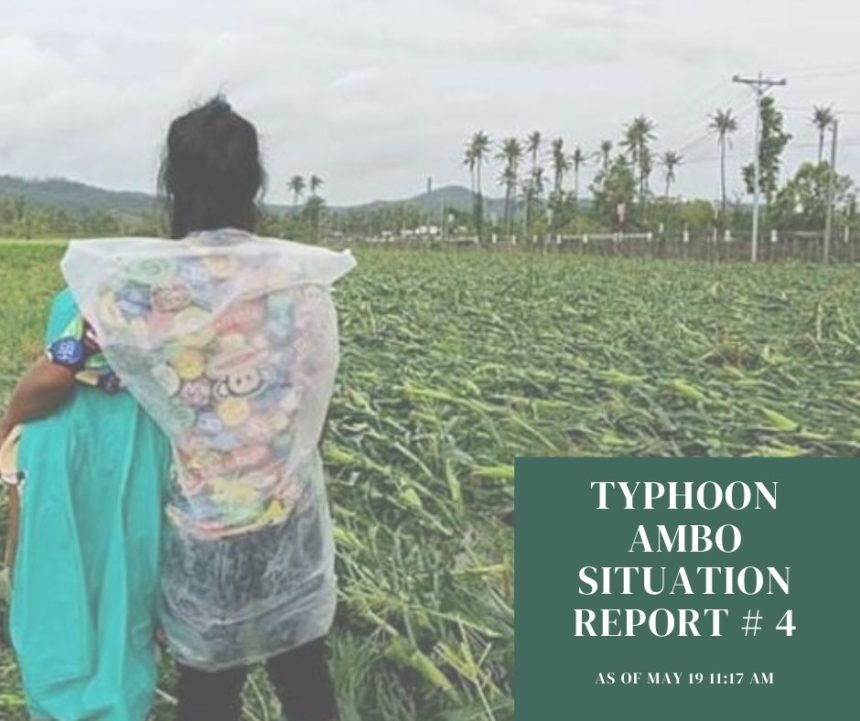Overall Situation
• Typhoon Ambo left the Philippine Area of Responsibility on May 18.
Reports on Affected Populations
• As of May 19, a total of 60,285 families (from the previous 25,474) or 218,400 persons (from the previous 82,563) are affected in 173 cities/municipalities (from the previous 59) in 36 provinces (from the previous 8) of CALABARZON, Region VIII, II, and CAR.
• Jipapad town Mayor Benjamin Ver said all the town’s 8,000 residents in 13 villages have been badly affected by the typhoon as flooding cut electricity, drinking water supply and communication.
• The provincial government of Eastern Samar reported that at least 4 people died in the towns of Oras and San Policarpo when the typhoon slammed the province on May 14. The weather disturbance also left at least 14 injured in the towns of Can-avid and San Policarpo.
• A total of 54 persons were injured in Regions III and VIII.
• A total of 2 bridges and 6 road section in Regions II, CALABARZON, VIII, and CAR were reported not passable. Of which, 1 bridge and 2 road sections remain not passable.
• Major roads in northern part of Eastern Samar and Northern Samar are not yet passable due to debris on the road. Roads in Paranas, Samar to Taft, Eastern Samar is temporarily closed due to possible landslides. While the road in San Roque going to Palapag, Northern Samar is not yet passable to any type of vehicle.
• Areas in the cities of Mandaluyong and Malabon were reported but already subsided.
• 95 structures (from the previous 12) were reported damaged in Regions V and VIII of which, 9 are health facilities.
Region/Province Particular Remarks
Hospital Facilities (9)
Region V
Albay Bicol Regional Diagnostic and Reference Laboratory, Legazpi City Temporarily no specimen collection and testing for COVID-19; not functional
Sorsogon Pantaleon G. Gotladera Memorial Hospital, Bulan Partially damaged/still functional
Donsol District Hospital Partiallydamaged/still functional
Irosin District Hospital Partially damaged/still functional
Region VIII
Western Samar Tarangnan Community Hospital Partially damaged/still functional
Eastern Samar Arteche Rural Health Unit Not functional (damaged roofing, medicines, records and equipment)
Maslog Rural Health Unit Partially damaged/still functional
San Policarpo Rural Health Unit Partially damaged/still operational
Oras Rural Health Unit Totally damaged/not functional
• The Mayor of Jipapad said flood water soaked 400 sacks of rice and assorted medicines intended for post-disaster relief operations
• DepEd reported a total of 75 damaged schools in Regions III (6), CALABARZON (7), MIMAROPA (1), V (43), VIII (17), and CAR (1).
• A total of 7,459 houses were damaged in Region VIII:
Region/Province/Municipality Totally Damaged Partially Damaged Total
Region VIII 1,128 6,331 7,459
Eastern Samar 1,051 5,706 6,757
Arteche 146 316 462
Can-avid 51 2,264 2,315
Maslog 104 476 580
San Policarpo 750 2,650 3,400
Northern Samar 77 625 702
Allen 29 88 117
Laoang 48 537 585
• A total of 255 areas in 18 provinces of Regions III, CALABARZON, MIMAROPA, V, VIII, and NCR experienced power line interruption. Of which, power in 63 areas was already restored.
• Jipapad, Arteche, San Policarpo, Oras, Dolores, and Maslog areas in Eastern Samar are experiencing signal interruption.
• Weak Globe signal and no signal for Smart was reported in Northern Samar.
• There are no reported strandees and ports already resumed operations in CALABARZON, MIMAROPA, Regions V, ad VIII.
• Typhoon Ambo had so far wrought damage and losses worth P1.04 billion to the agriculture sector, leaving as many as 21,655 farmers and fisherfolk reeling from its impact.
• Based on a data from the Department of Agriculture’s Disaster Risk Reduction and Management Council, Ambo’s onslaught have so far resulted in production loss of 62,228 MT with as much as 20,652 hectares of agricultural areas damaged.
• The damage covers several areas in Central Luzon, CALABARZON, Bicol, and Eastern Visayas regions.
• It turns out that most affected agriculture commodities would be high value crops, accounting for 73% or P755.57 million of the total damage and losses. Some of the most badly hit products are bananas and papayas in Quezon province.
• A total of 34,675 families (from the previous 19,141) or 136,100 persons (from the previous 71,730) were pre-emptively evacuated in Regions II, CALABARZON, MIMAROPA, V, VIII, and CAR.
• The Regional Disaster Risk Reduction and Management Council of Eastern Visayas reported that until the night of May 17, there were still over 23,000 residents staying in evacuation centers after the typhoon washed out their houses.
(Sources: NDRRMC, Philippine News Agency)
Emergency Response Efforts
• On May 15, CDRC started releasing its Situation Reports.
• LCDE also submitted its Situation Report.
Resources Available
• Standby emergency funds
• Prepositioned goods at the CDRC warehouse
Expressed Needs
• Immediate needs of the survivors include hygiene kits, water, medicine, cash, shelter kit, food, and psychosocial support to both children and adults.
Coordination
Regional Center
• Southern Tagalog People’s Response Center (STPRC)
• Leyte Center for Development (LCDE)
• Tarabang para sa Bicol (TABI)
Contacts
• Kim Augiline Leduna, Executive Director, (insert cellphone number), info@cdrc-phil.com
• Malen Serato, Field Operations Department, 0916-499-1410, fod@cdrc-phil.com
• Hanna Fiel, Research and Public Information Department, 0945-8355589, hanna.fiel.cdrc2019@gmail.com
• Cora Jazmines, Local Partnerships Department, 0949-845-1271, lpd@cdrc-phil.com
TYPHOON AMBO Situation Report #4 May 19, 2020, 11:17 am

